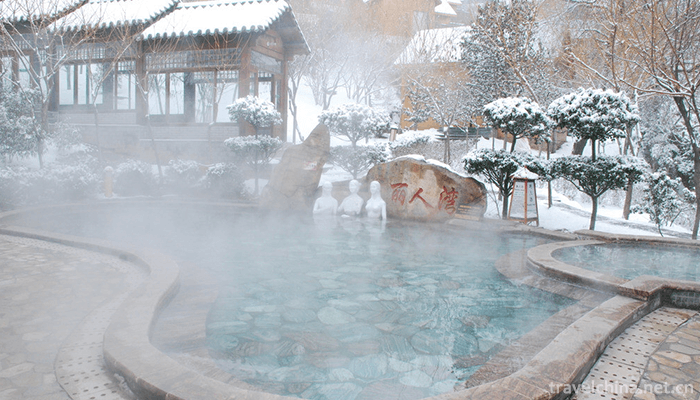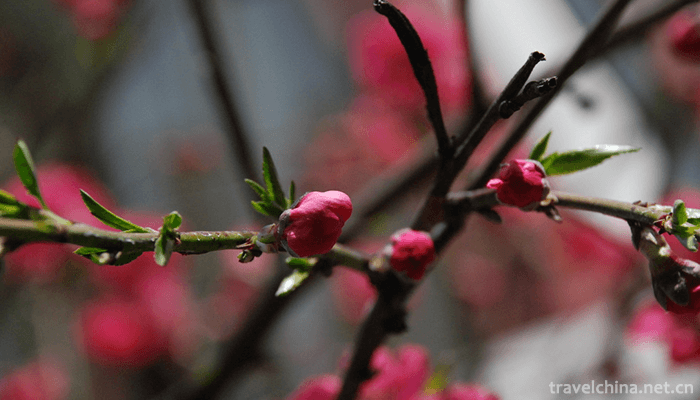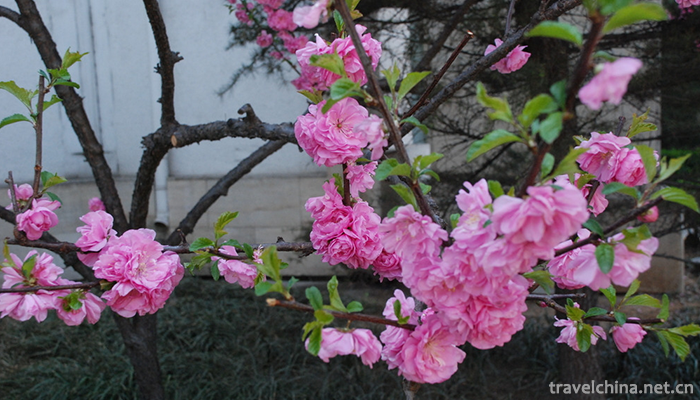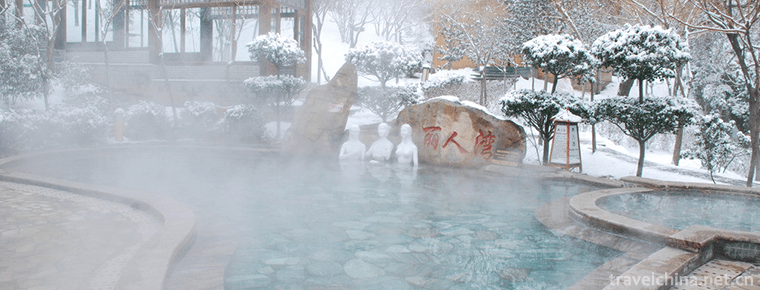White Deer hot spring bailu hot spring
Bailu Hot Spring is a hot spring resort center built according to the national AAAA scenic standard. Located in Wentang Town, Pingshan County, Shijiazhuang City, Hebei Province, Bailu Hot Spring is a new and comprehensive hot spring resort center integrating hot spring bathing, leisure health care, eco-tourism, perfect accommodation, dining, entertainment and shopping. The center is adjacent to Xibaipo, a famous revolutionary sacred place in China, and with the scenic spots of Tiangui Mountain and Tuoliang Mountain. The area is adjacent, the traffic is convenient and the scenery is pleasant.
Characteristics of scenic spots
Bailu Hot Spring uses the underground hot spring water with a long history in Wentang Town. It has a constant temperature of 70 degrees all the year round. The spring water is rich in more than 30 mineral and trace elements beneficial to human health. It belongs to the health-care high-temperature radon spring with smooth water quality, good health and beauty, physiotherapy and physical and mental health. It has a good auxiliary effect on rheumatism, arthritis and other diseases. According to historical records, Emperor Wudi of Han Dynasty once imperial seal this spring as "the holy water of Baoquan".
Bailu Hot Spring, with its unique cultural background and brand-new hot spring products, is leading the bathing trend of hot springs in North China and striving to shape a new image of the fifth generation of hot springs in China. While fusing the natural, comfortable, dynamic and healthy products of hot springs, we intend to highlight the cultural and differences of hot springs products. Its products are divided into dynamic zone, health SPA zone, cultural zone, exotic zone, Beauty Bay, Valley of Traditional Chinese Medicine and other 47 hot spring pools of different sizes and styles. The supporting lobby can provide newspapers, drinks, fruits and snacks free of charge, as well as table tennis, billiards, sandpot, Internet cafes, gym and other entertainment items free of charge. In the hot spring dynamic zone, there are large-scale hot spring water recreation projects, such as hot spring wave making pool, hot spring tricolor slide, hot spring swimming pool and so on. In addition, there are also health services such as cleaning, health care, traditional Chinese medicine physiotherapy and pure Nanyang SPA set meals.
Bailu Hot Spring originates from the underground health-care high-temperature radon spring water rich in more than 30 minerals and trace elements. It is smooth as fat, healthy and moisturizing, physiotherapy and physical and mental therapy. It has good auxiliary curative effect on many diseases. Bailu Hot Spring is the best product of hot springs. Its water is rich in rare element radon, also known as "radon spring". For rheumatoid arthritis, dermatosis, neurasthenia, cold and cosmetic whitening, smooth skin, especially for the treatment of skin diseases and tumors have a special effect. In ancient times, Emperor Wudi of the Han Dynasty was awarded the title of "Baoquan Holy Water".
Since ancient times, Hot Pond is a treasure land in the west of Hebei Province. It has long been famous for hot springs and is one of the key mineral spring convalescent areas in China. The hot spring water in Wentang is mainly distributed in the Xihe Valley Basin. It is controlled by faults in the northeast and southwest directions and distributes in strips with a length of 2 kilometers and a width of 0.5 kilometers. The thermal reservoir belongs to the active structural fault water-bearing zone of Mixed gneiss in the Fuping Group of the Archean Pre-Sinian. The hot water originates from the surface below 40 meters. Its bedrock is Archean rocks, overlying Quaternary unconsolidated sediments, and dikes are transmitted and interpolated in metamorphic rocks. Compact, because of the influence of Mesozoic orogeny, bedrock causes complex folds and faults. Atmospheric precipitation infiltrates deep underground through various complex channels along rock crevices, dissolves high temperature chloride and sulfate in bedrock under high temperature conditions, and obtains higher temperature. Under the static pressure produced by the difference between the height of hot water recharge area and outcrop area in the southern and southwestern mountainous areas of Wentangcun, underground hot water rises to surface springs in the structural fracture channel of lower valleys.
Measured in the 1950s and 1960s, the self-effluent volume was 69.5 cubic meters per hour. After the mid-1980s, the daily production volume reached 1600 cubic meters. The hot springs at the outlet ranged from 60 degrees to 70 degrees all the year round. The hydrochemical type was sulfur-sodium chloride type with a salinity of 1.7 mg/l.
Water contains chlorine, potassium, sodium, boron, calcium, magnesium, iron, radon and other minerals and chemical nutrients. It can treat more than 40 kinds of chronic diseases, especially for dermatitis, sequelae of sports trauma, peripheral nerve and various neuropathic diseases. Among them, inert gas radon has the function of alleviating cardio-cerebral reserve canal disease, which shows a broad space for geriatric rehabilitation medicine.
In addition, hot spring water also has a high value of physiotherapy and cosmetology. Long-term bathing can achieve the function of dredging meridians, dredging collaterals and delaying aging.
Main attractions
Peach blossom pool
Peach blossom pool is shaped like peach petals, which means good luck. It is said that young people bathing in peach blossom water during Peach Blossom Festival can keep young people away from diseases, and in the new year, good luck and good luck will grow with each other. Legend has it that the seven fairies went down to the earth and went to the hot spring in the stream covered by peach blossoms, and then left. This scene was discovered by the villagers in Taolin. They also changed their clothes and bathed, and the hot spring was fragrant and lubricated their skin. On this day, the official lunar calendar was abused on the third day, serving the people in the hot pond positioned this day as the annual temple fair day, and March is also known as "Gu Xiyue", which has been circulated to this day.
The nine day pool sea
There are nine heavens in ancient legends. Nine heavens are the highest level of heaven. Nine days refer to the place where the legendary Jade Emperor lived. Later it was described as a very high sky. The emperor called Nine Five Supreme and Nine Yangshu, so the purpose of building Nine Tianchihai was to celebrate the great achievements of great men and their contributions to history.
White Deer soup
Legend has it that Emperor Wudi of Han Dynasty once asked the Queen Mother for a good prescription for treating facial sores. One day, he traveled along the hot spring to a hill west of the pond to feel tired. When he rested, the White Deer scratched out a hot water with his feet. After bathing in the water, Emperor Wudi of Han was instantly refreshed, radiant and clean. After the death of the white deer, Emperor Wudi of the Han Dynasty ordered people to transport the white deer to Bailutai for burial. To commemorate the contribution of White Deer, we specially repair this spring, named Bailu Shentang!
Tourism information
Self driving route
Shijiazhuang North Second Ring Shiyan Road Pingshan Wentang Bailu Hot Spring Scenic Area
Shijiazhuang North Second Ring Shitai Expressway Wentangkou Bailu Hot Spring Scenic Area
Taiyuan Yangqu Yuxian Jiaokou Qingfeng Bailu Hot Spring
Taiyuan Taijiu Expressway Beijing-Kunming Expressway Xibaipo Expressway Wentang Exit Bailu Hot Spring
Shijiazhuang Shiyan Road Pingshan County Town Wentang Town Bailu Hot Spring Scenic Area
Shijiazhuang North Second Ring Shitai Expressway Wentangkou Bailu Hot Spring Scenic Area
Taiyuan departure: take Taijiu Expressway to Yuxian Dongxia Expressway, take National Highway 207 to Xibaipo to turn to Hot Spring, the whole journey is about 2.5 hours.
Bus
Shijiazhuang North Station Chengping Shi Express Passenger to Bailu Hot Spring, Wentang Town. A 30-minute train
The hot spring area is divided into dynamic area, children's area, health care area and cultural area. There are more than 60 functional hot spring pools with different styles. While soaking, tourists can also receive professional massage, traditional Chinese medicine physiotherapy and pure Nanyang SPA set meals.




-
1.Shoulds ancestral hall
Yanmenguan Scenic Spot is located in the northern part of Daizhou ancient city. South-controlled Central Plains and North-controlled Moyuan are grand military defense projects of ancient Chinese passe
Time 2018-11-24 -
2.Xixi National Wetland Park
Xixi National Wetland Park is located in the west of Hangzhou City, Zhejiang Province. It is only 6 kilometers away from Wulin Gate, the main city of Hangzhou, and 5 kilometers away from West Lake.
Time 2018-12-07 -
3.Cai Lun Zhuhai
Cai Lunzhuhai is located in Huangshi Town and Dayi Town, Leiyang City, a famous historical and cultural city in central and southern China. It covers an area of 100 square kilometers and has a central
Time 2019-01-04 -
4.Drum dance
Hani rhythm and drum dance is a kind of sacrificial dance of Hani people on the traditional festival "Onmatu". The dance is vigorous and bold, vigorous, simple and free, showing the same per
Time 2019-05-23 -
5.Nanxian Flower Drum
On May 20, 2006, the local flower drum of Nanxian County was listed in the first batch of national intangible cultural heritage list with the approval of the State Council.
Time 2019-06-07 -
6.The technical skill of penjing
Bonsai art refers to the Soviet bonsai art, which originated in the Tang Dynasty, flourished in the Ming Dynasty, matured in the Qing Dynasty, and developed in modern times. Since the 1980s, Suzhou Bo
Time 2019-06-09 -
7.Qijia Yanxi
"Qijia Yanxi" is a long narrative poem in Tu folk literature. It records the eleventh generation of Qi Tusi Chief Qi Yanxi in the history of Tu people, despite his old age and physical decli
Time 2019-06-10 -
8.Legend of Su Xian
The legend of Suxian is a local folklore with a long history. Su Xian, Ming Lian, from Guiyang. Su Da lost his father in his early years and depended on his mother for his life. One year, the plague w
Time 2019-06-17 -
9.Triple Drum Jump
Dancing three drums is a kind of opera which is popular in counties (cities) such as public security, Shitou, Jiangling and Songzi. It evolved from the funeral board and funeral drum song of sacrifici
Time 2019-06-21 -
10.Really Different zhenbutong Making Skills of Luoyang Watermat
It's really different from Luoyang's water mat making skills. The traditional handicraft in Luoyang City, Henan Province, is one of the national intangible cultural heritages.
Time 2019-07-25 -
11.The Bronze Drum Custom of the Zhuang Nationality
Bronze drum is a percussion instrument created by Pu and Yue people in ancient China. Up to now, it has a history of more than 2700 years. Guangxi has the largest number and the widest distribution. T
Time 2019-08-16 -
12.Social undertakings in Guangyuan
In 2018, Guangyuan City achieved 31 major scientific and technological achievements throughout the year, and 1466 patents were applied, including 288 inventions and 931 authorized patents. 84 technical contracts were registered, and the transaction value
Time 2020-12-15